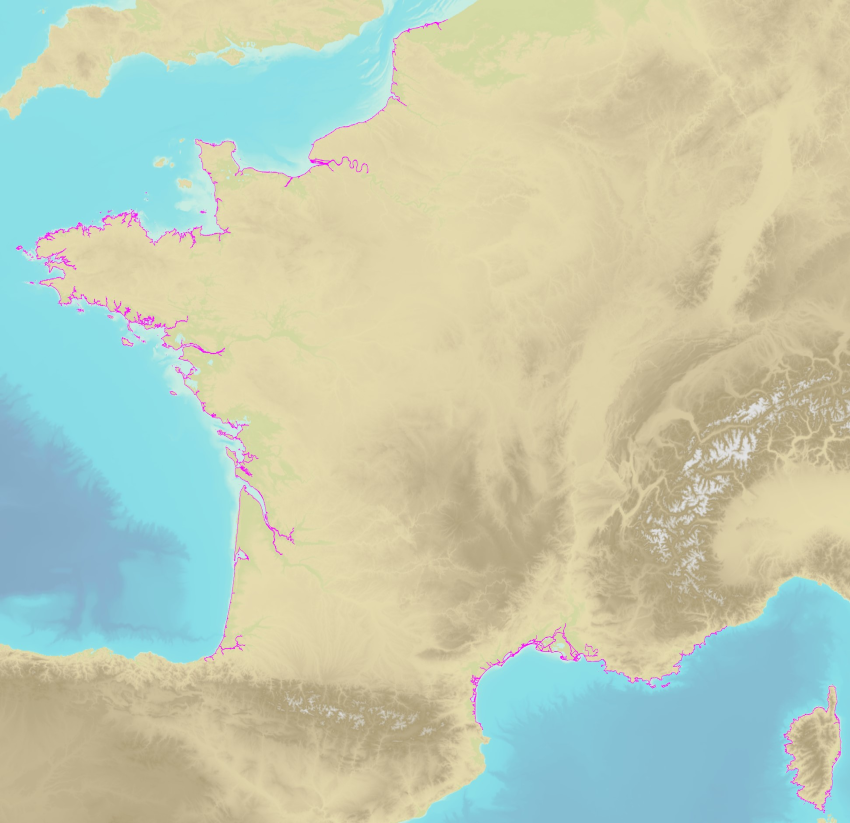2000
Type of resources
Available actions
Topics
Keywords
Provided by
Years
Formats
Representation types
Update frequencies
status
Scale
Resolution
-

The land-sea limit corresponds to the Highest Astronomical Tide (HAT) in the case of a tide of coefficient 120 and under normal meteorological conditions (no offshore wind and mean atmospheric pressure of 1013 hPa). This geometric line is naturally defined as the intersection of a HAT model (extended to the coast and the top end of the upper estuary) based on the available Bathyelli surfaces, and a high-resolution digital terrain model of the coastal area. It corresponds to the highest limit of the intertidal area and takes into account, when they exist, the 3 administrative maritime limits which are: the transversal limit of the sea (LTM), the salt water limit (LSE) and the limit of maritime jurisdiction (LAM). This limit is measured (quoted) in relation to the local hydrographic chart datum and to the levels of reference for France (IGN69 and IGN78 for Corsica). Relations to other levels of reference (mean sea level and ellipsoid) are known. The land-sea limit product, mainly results from the exploitation of the two products Litto3D®/RGEALTI® and Bathyelli, and represents, with a metric resolution (1 to 5 metres), this theoretical entity by a set of 2D polylines describing the nature of the coast (artificial or natural, rocky or sandy, steep or flat, etc.). The method used for calculating the land-sea limit makes it possible to produce a continuous, homogeneous and spatially coherent limit on the entire French metropolitan coastal area.
-

The land-sea limit corresponds to the Highest Astronomical Tide (HAT) in the case of a tide of coefficient 120 and under normal meteorological conditions (no offshore wind and mean atmospheric pressure of 1013 hPa). This geometric line is naturally defined as the intersection of a HAT model (extended to the coast and the top end of the upper estuary) based on the available Bathyelli surfaces, and a high-resolution digital terrain model of the coastal area. It corresponds to the highest limit of the intertidal area and takes into account, when they exist, the 3 administrative maritime limits which are: the transversal limit of the sea (LTM), the salt water limit (LSE) and the limit of maritime jurisdiction (LAM). This limit is measured (quoted) in relation to the local hydrographic chart datum and to the levels of reference for France (IGN69 and IGN78 for Corsica). Relations to other levels of reference (mean sea level and ellipsoid) are known. The land-sea limit product, mainly results from the exploitation of the two products Litto3D®/RGEALTI® and Bathyelli, and represents, with a metric resolution (1 to 5 metres), this theoretical entity by a set of 2D polylines describing the nature of the coast (artificial or natural, rocky or sandy, steep or flat, etc.). The method used for calculating the land-sea limit makes it possible to produce a continuous, homogeneous and spatially coherent limit on the entire French metropolitan coastal area.
-
Ce jeu de données représente sous forme de ponctuels les dispositifs destinés à protéger le réseau d'eau potable contre des sous-pressions ou des surpressions.
-
Carte Communale (CC) numérisée. Ce lot informe du droit à bâtir sur la commune de ISSIGEAC. Cette CC est numérisée conformément aux prescriptions nationales du CNIG.
-
Réseau d'eau potable (canalisations et ouvrages de défense incendie) du syndicat intercommunal d'alimentation en eau potable et d'assainissement (SIAEPA) de Saint Selve (communes de Saint-Selve, Saint-Morillon, Saint-Michel-de-Rieufret)
-
Carte Communale (CC) numérisée. Ce lot informe du droit à bâtir sur la commune de CONNE-DE-LABARDE. Cette CC est numérisée conformément aux prescriptions nationales du CNIG.
-
Plan Local d'Urbanisme (PLU) numérisé. Ce lot informe du droit à bâtir sur la commune de PEUJARD. Ce PLU est numérisé conformément aux prescriptions nationales du CNIG.
-
Couche SIG en cours d'élaboration (version de travail) de dolines (dépression fermée caractéristique du karst) réalisées dans le cadre du projet EauxScars à l'aide d'une méthodologie de détection automatique basée sur le traitement de modèle numérique de terrain haute définition (RGE ALti V2 IGN). L'emprise d'étude correspond aux formations carbonatées des départements de Charente, Dordogne, du Lot et du Lot et Garonne. Couche SIG mise à disposition de la communauté pour avis et complément durant le 1er semestre 2022. Envoyez un mail à eaux-scars@brgm.fr pour la récupérer. https://sigesaqi.brgm.fr/-Projet-Eaux-SCARS-.html
-
Carte Communale (CC) numérisée. Ce lot informe du droit à bâtir sur la commune de FAUX. Cette CC est numérisée conformément aux prescriptions nationales du CNIG.
-
Le SIAEP Luy et Gabas alimente en eau potable 42 communes du Nord-Est des Pyrénées-Atlantiques. Les plans de réseau datent de 2010.
 Catalogue PIGMA
Catalogue PIGMA